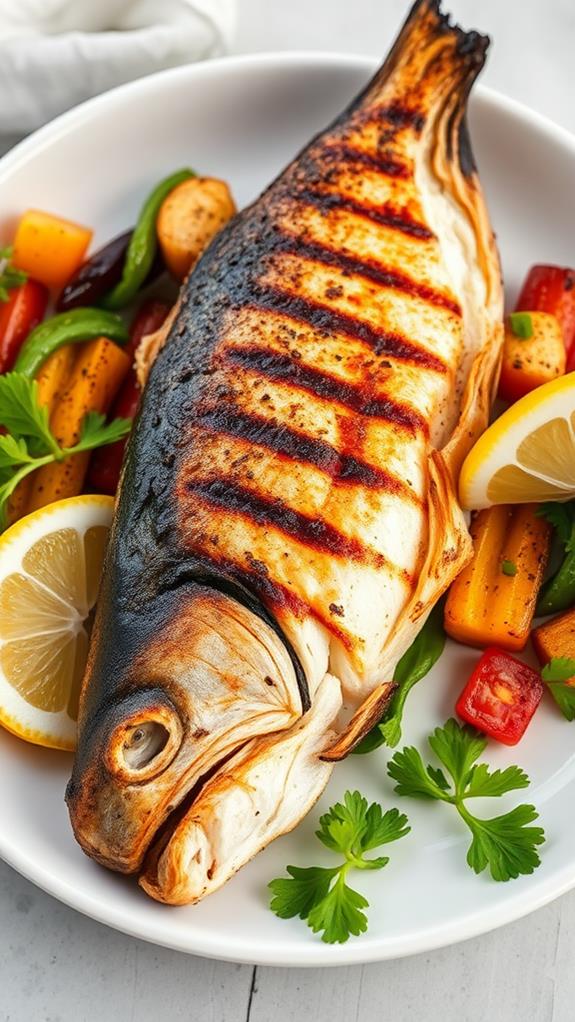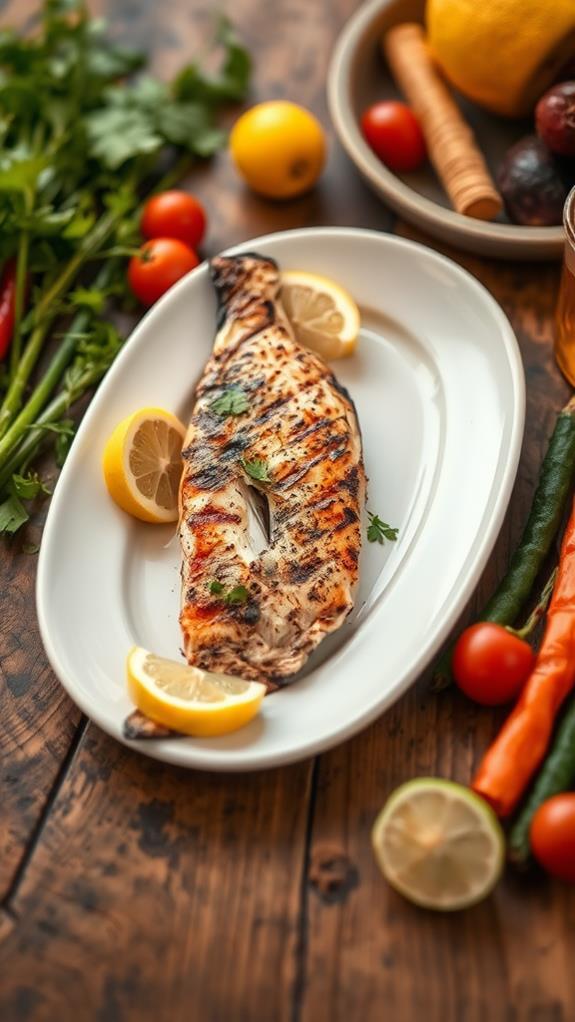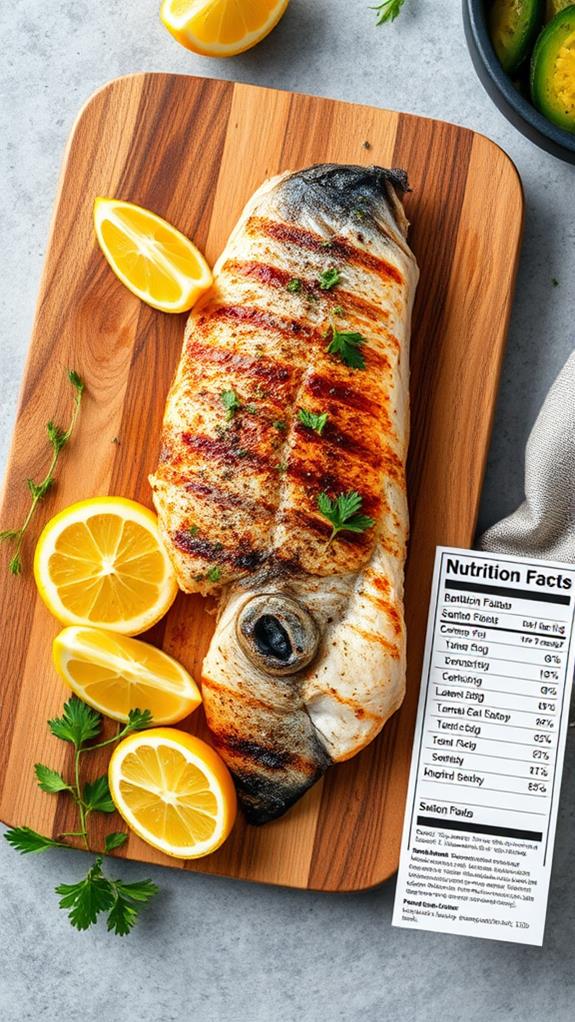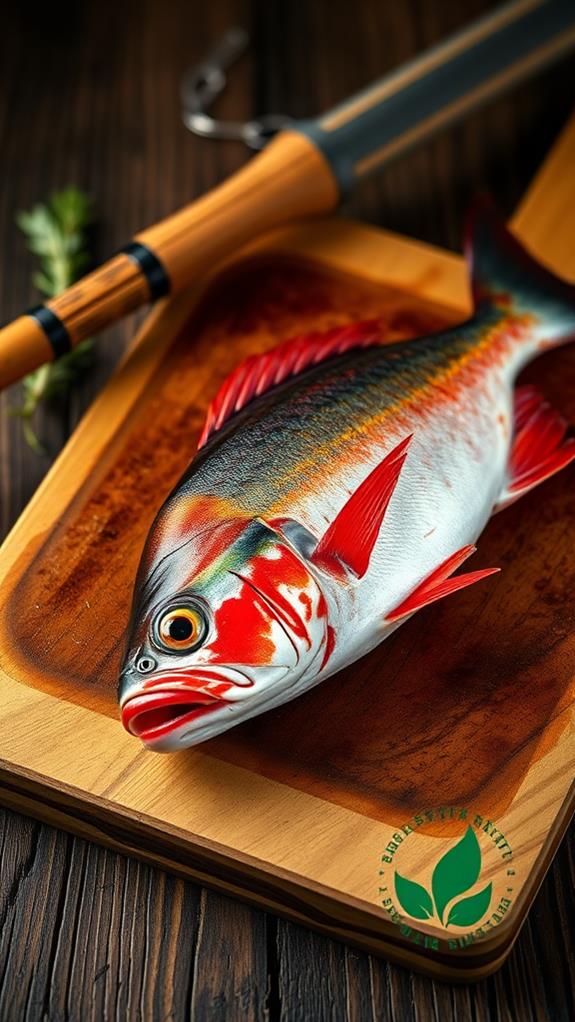Is Amberjack Safe to Eat
Amberjack can be safe to eat, but you should be aware of potential risks. It's a nutritious fish, rich in protein and omega-3 fatty acids. However, it's classified as a high-mercury fish, so you should limit your consumption to 6 ounces per week for adults. Proper cooking is essential to eliminate parasites and bacteria; aim for an internal temperature of 145°F (63°C). When selecting amberjack, look for clear eyes, firm flesh, and a mild ocean smell. While it offers health benefits, pregnant women and children should be cautious. By understanding the risks and following guidelines, you can make informed decisions about including amberjack in your diet. The following information will equip you with more knowledge to facilitate safe consumption.
This post may contain affiliate links. If you make a purchase through these links, I may earn a commission at no additional cost to you. Additionally, portions of this post may be generated using artificial intelligence (AI) technology. While we strive for accuracy, please be aware that AI-generated content may not always be perfect and should be fact-checked when necessary.
The Spatula Scoops
- Amberjack is generally safe to eat when properly sourced and prepared, but contains high mercury levels.
- The FDA recommends limiting amberjack consumption to 6 ounces per week for adults due to mercury content.
- Proper cooking techniques, including reaching an internal temperature of 145°F (63°C), eliminate parasites and bacteria risks.
- Pregnant women, nursing mothers, and young children should avoid or limit amberjack consumption due to mercury concerns.
- Sourcing amberjack from reputable suppliers and using sustainable fishing practices can enhance safety and quality.
Nutritional Profile of Amberjack

Diving into the nutritional profile of amberjack reveals a fish packed with essential nutrients. You'll find that this seafood is an excellent source of high-quality protein, providing all the essential amino acids your body needs. It's also rich in omega-3 fatty acids, particularly EPA and DHA, which are of the utmost importance for heart and brain health. Like salmon, amberjack offers significant heart health benefits due to its omega-3 content, potentially reducing the risk of cardiovascular disease.
Amberjack is a low-calorie option, making it ideal for those watching their weight. It's packed with vitamins and minerals, including vitamin B12, niacin, and selenium. These micronutrients play indispensable roles in energy metabolism, DNA synthesis, and antioxidant defense.
The fish is relatively low in mercury compared to some other large predatory fish, though it's still advisable to consume it in moderation. It bears noting that the exact nutritional content can vary depending on the species of amberjack and how it's prepared.
For those concerned about SEO, incorporating keywords like "amberjack nutrition" and "health benefits of amberjack" can improve your content's visibility in search engine results pages (SERPs). Remember, providing accurate, valuable information is of paramount importance for both your readers and search engine algorithms.
Mercury Levels in Amberjack
When it comes to mercury levels in amberjack, it is essential to understand the facts. Amberjack, like many large predatory fish, accumulates mercury in its tissues over time. The FDA and EPA have classified amberjack as a "high mercury" fish, which means it contains more than 0.3 parts per million (ppm) of mercury. Similar to chicken, where proper cooking temperatures are vital for safety, monitoring mercury levels in fish is indispensable for consumer health.
You should be aware that consuming fish with high mercury levels can pose health risks, especially for pregnant women, nursing mothers, and young children. Mercury is a neurotoxin that can affect brain development and function. However, this doesn't mean you need to completely avoid amberjack. The key is moderation.
For adults, it's generally recommended to limit consumption of high-mercury fish to no more than 6 ounces per week. If you're pregnant or nursing, you might want to consult with your healthcare provider about safe consumption levels. It's also worth noting that smaller, younger amberjack typically have lower mercury levels than larger, older specimens. When possible, opt for smaller fish to reduce your mercury exposure while still enjoying the nutritional benefits of amberjack.
Health Benefits of Eating Amberjack

Despite concerns about mercury levels, amberjack offers several health benefits when consumed in moderation. You'll find that this fish is an excellent source of lean protein, providing essential amino acids for muscle growth and repair. It's also rich in omega-3 fatty acids, which can help reduce inflammation and support heart health. Similar to oxtail, amberjack is a nutrient-dense food that can boost your immune system functions and metabolism when prepared properly.
Amberjack contains various vitamins and minerals that contribute to your overall well-being. It's a good source of vitamin B12, paramount for nerve function and red blood cell formation. You'll also get a healthy dose of selenium, an antioxidant that supports your immune system and thyroid function. The fish provides phosphorus, important for bone health and energy metabolism.
When you include amberjack in your diet, you're adding a low-calorie, nutrient-dense food to your meals. It's particularly beneficial if you're looking to maintain a healthy weight while ensuring adequate nutrient intake. The fish's high protein content can help you feel full longer, potentially reducing overall calorie consumption. Remember, though, that preparation methods matter. Opt for grilling, baking, or broiling instead of frying to maximize the health benefits and minimize added fats.
Potential Risks and Concerns
Caution is warranted when considering amberjack consumption due to several potential risks. The primary concern is ciguatera poisoning, a foodborne illness caused by eating fish that have consumed toxin-producing algae. Amberjack, particularly larger specimens, can accumulate these toxins, which aren't destroyed by cooking or freezing.
You should also be aware of mercury content in amberjack. As a predatory fish, it tends to accumulate higher levels of mercury than smaller species. This can be particularly problematic for pregnant women, nursing mothers, and young children.
Another risk factor is the potential for parasites in raw or undercooked amberjack. While proper cooking can eliminate this risk, it is crucial to guarantee your fish is thoroughly cooked if you're concerned about parasitic infections.
Lastly, some individuals may experience allergic reactions to amberjack or other fish. If you have a known fish allergy or are trying amberjack for the first time, it is prudent to exercise caution and start with a small portion to gauge your body's response. Always consult with a healthcare professional if you have specific dietary concerns or medical conditions.
Recommended Consumption Guidelines

Given the potential risks associated with amberjack consumption, it's important to follow specific guidelines to enjoy this fish safely. The FDA recommends limiting your intake of amberjack to no more than 6 ounces per week for adults and 2-3 ounces per week for children. This moderation helps minimize your exposure to potential toxins like mercury and ciguatoxin.
When preparing amberjack, ensure it's thoroughly cooked to an internal temperature of 145°F (63°C) to eliminate any parasites or bacteria. It's also critical to source your amberjack from reputable suppliers who follow proper handling and storage practices. If you're pregnant, nursing, or have a compromised immune system, you might want to avoid amberjack altogether or consult with your healthcare provider before consuming it.
To optimize the SEO of content related to amberjack consumption, use relevant keywords like "amberjack safety," "fish consumption guidelines," and "mercury in fish." Incorporate these terms naturally into your content, maintaining a keyword density of around 1-2% for ideal search engine visibility without compromising readability. Remember, quality content that addresses user intent will rank better in search results.
Selecting Fresh Amberjack
When you're shopping for amberjack, knowing how to select fresh fish is crucial for both safety and flavor. Look for clear, bright eyes and shiny, metallic skin with no discoloration or bruising. The gills should be bright red or pink, not brownish or slimy. Fresh amberjack will have a mild, ocean-like smell, not a strong fishy odor.
If you're buying fillets, they should be firm to the touch and have a translucent appearance. Avoid any that look dry, dull, or have brown edges. The flesh should spring back when lightly pressed and shouldn't leave an indentation.
When possible, ask the fishmonger about the fish's origin and when it was caught. Opt for amberjack that's been sustainably caught and properly handled. If you're unsure about the freshness, don't hesitate to ask for a closer look or a sniff test.
Safe Preparation Methods

To guarantee your amberjack is safe to eat, you'll need to focus on proper cooking techniques and fresh handling practices. When it comes to cooking, make certain you're heating the fish to an internal temperature of at least 145°F (63°C) to kill any potential parasites or harmful bacteria. Before cooking, always manage raw amberjack with clean hands and utensils, keeping it refrigerated until you're ready to prepare it, and avoid cross-contamination with other foods.
Proper Cooking Techniques
How can you guarantee your amberjack is safe to consume? The key lies in proper cooking techniques. You'll want to verify that the internal temperature of the fish reaches at least 145°F (63°C). This temperature effectively kills any harmful parasites or bacteria that might be present in the flesh.
When grilling amberjack, preheat your grill to medium-high heat. Cook the fish for about 4-5 minutes per side, depending on thickness. For pan-searing, heat oil in a skillet over medium-high heat and cook for 3-4 minutes per side. Baking is another excellent option; preheat your oven to 400°F (204°C) and bake for 10-12 minutes.
Regardless of the method you choose, use a meat thermometer to check the internal temperature. Insert it into the thickest part of the fish to verify accuracy. Don't rely solely on visual cues, as the fish may appear cooked on the outside while still being undercooked internally. Remember, thorough cooking is essential for food safety, especially when dealing with amberjack, which can harbor parasites if not prepared correctly.
Fresh Handling Practices
Fresh handling practices are essential for safeguarding your amberjack's safety before it even reaches the cooking stage. When you're purchasing amberjack, look for firm flesh with a fresh, oceanic smell. Avoid fish with a strong, fishy odor or discolored spots. Once you've made your selection, it's imperative to keep the fish cold. If you're not heading straight home, consider bringing a cooler with ice to maintain the appropriate temperature.
Upon arriving home, immediately refrigerate your amberjack at 40°F (4°C) or below. Don't let it sit out at room temperature, as this can promote bacterial growth. If you're not planning to cook the fish within two days, freeze it promptly. When you're ready to prepare the amberjack, thaw it in the refrigerator, never on the counter.
Before cooking, rinse the fish under cold water and pat it dry with paper towels. Use separate cutting boards and utensils for raw fish to prevent cross-contamination. Always wash your hands thoroughly before and after handling raw amberjack. These practices will help verify that your amberjack remains safe and delicious from purchase to plate.
Alternatives to Amberjack
If you're looking for alternatives to amberjack, you've got plenty of options that can satisfy your seafood cravings. Similar-tasting fish species like mahi-mahi, yellowtail, or grouper can provide a comparable flavor profile while potentially offering safer and more sustainable choices. You might also consider exploring other seafood options that are known for their safety and sustainability, such as wild-caught salmon, farmed tilapia, or Pacific cod.
Similar Tasting Fish Species
Anglers and seafood enthusiasts often seek alternatives to amberjack that offer similar taste profiles. If you're looking for fish with comparable flavors and textures, you'll find several options worth trying. Yellowtail, also known as hamachi, is a popular choice that shares amberjack's rich, buttery texture and mild flavor. Mahi-mahi, or dorado, offers a similar firm texture with a slightly sweeter taste.
For those who enjoy amberjack's meaty consistency, you might consider trying wahoo or king mackerel. These fish have a more pronounced flavor but maintain a comparable texture. Tuna, particularly yellowfin or bigeye, can be an excellent substitute, offering a similar richness and versatility in cooking methods. If you're after a milder taste, try cobia, which has a subtle sweetness and firm flesh reminiscent of amberjack.
When selecting alternatives, consider the fish's sustainability and mercury content. Some species, like yellowtail and mahi-mahi, are generally considered more sustainable choices. Always check local fishing regulations and consume these fish in moderation, especially if you're concerned about mercury levels. By exploring these options, you'll expand your palate while potentially finding new favorites that align with your dietary preferences and environmental concerns.
Safer Seafood Options
When considering safer seafood alternatives to amberjack, you'll find several options that offer both nutritional benefits and lower health risks. Salmon, for instance, is an excellent choice due to its high omega-3 content and lower mercury levels. It's a versatile fish that you can prepare in numerous ways, from grilling to baking.
Another safe option is cod, a mild-flavored white fish that's low in mercury and high in protein. You'll find it's easy to cook and works well in various dishes. Trout is another alternative worth exploring, as it's rich in nutrients and generally considered a low-mercury fish.
If you're looking for something similar to amberjack's texture, try mahi-mahi. It's a firmer fish with a sweet flavor and contains less mercury than amberjack. Pollock is another safe choice, often used in fish sticks and imitation crab meat. It's low in mercury and high in protein.
Sustainable Fishing Alternatives
Considering the growing concern for ocean health, exploring sustainable fishing alternatives to amberjack is essential. You'll find numerous options that are both environmentally friendly and delicious. One popular choice is mahi-mahi, which has a similar taste and texture to amberjack but reproduces quickly, making it more sustainable. Another option is yellowtail, which is often farm-raised using responsible aquaculture practices.
If you're looking for a different flavor profile, try Atlantic mackerel or sardines. These small, oily fish are abundant and have short life cycles, making them excellent sustainable choices. They're also rich in omega-3 fatty acids and other nutrients. For a milder taste, consider farm-raised tilapia or rainbow trout, both of which have minimal environmental impact when raised responsibly.
When shopping for sustainable seafood, look for certifications like the Marine Stewardship Council (MSC) label or the Aquaculture Stewardship Council (ASC) seal. These indicate that the fish has been caught or farmed using environmentally responsible methods. You can also use smartphone apps like Seafood Watch to make informed choices while shopping or dining out. By choosing sustainable alternatives, you'll help protect marine ecosystems and guarantee the long-term availability of seafood.
Sustainability and Fishing Practices

For sustainability-conscious consumers, amberjack fishing practices are an essential consideration. You'll want to understand how these fish are caught and managed to make informed choices. Amberjack populations are generally well-managed, with most fisheries employing sustainable practices. Hook-and-line methods are commonly used, which minimize bycatch and habitat damage.
However, you should be aware that some regions face overfishing challenges. It's paramount to check the source of your amberjack and look for certifications like the Marine Stewardship Council (MSC) label. This certification guarantees the fish comes from a sustainable fishery.
Many countries have implemented quotas and size limits to maintain healthy amberjack populations. These measures help prevent overfishing and allow young fish to reach maturity before being harvested. You can support these efforts by choosing amberjack caught using sustainable methods and from well-regulated fisheries.
When buying amberjack, ask your fishmonger about its origin and fishing method. By doing so, you're not only guaranteeing a safer meal but also contributing to the long-term health of marine ecosystems and the fishing industry.
Frequently Asked Questions
What Does Amberjack Taste Like Compared to Other Fish?
You'll find amberjack has a distinct taste compared to other fish. It's often described as mild and sweet, with a firm, meaty texture. Unlike delicate white fish, amberjack's flavor is more robust, similar to tuna or swordfish. It's less fishy than mackerel or sardines but more flavorful than cod or tilapia. The taste can vary slightly depending on the specific species and where it's caught. Many people enjoy its versatility in cooking, as it holds up well to grilling and searing.
Can Pregnant Women Eat Amberjack?
Are you expecting and wondering about your seafood options? While amberjack can be a delicious choice, pregnant women should exercise caution. You should limit your consumption of amberjack due to its potential mercury content. It's best to consult your healthcare provider for personalized advice. If you do eat amberjack, guarantee it's fully cooked to minimize the risk of foodborne illnesses. Remember, there are many other fish options that are generally considered safer for pregnant women.
Is Amberjack Suitable for Sushi or Sashimi Preparations?
Yes, amberjack is suitable for sushi and sashimi preparations. You'll often find it in Japanese restaurants, where it's known as "kanpachi" or "hamachi," depending on its size. It's prized for its firm texture and rich, buttery flavor. When preparing amberjack for raw consumption, guarantee it's fresh and properly handled to minimize the risk of foodborne illness. Freezing the fish before use can also help eliminate potential parasites. As with any raw fish, it is critical to source it from reputable suppliers.
How Long Can You Store Fresh Amberjack in the Refrigerator?
Like a ticking clock, fresh amberjack's quality countdown begins the moment it's caught. You'll want to store it properly in your refrigerator to maximize its shelf life. Generally, you can keep fresh amberjack in the fridge for up to two days. Wrap it tightly in plastic or store it in an airtight container to prevent exposure to air and moisture. For longer storage, you should freeze it, where it can last up to six months while maintaining its quality.
Are There Any Cultural or Religious Restrictions on Consuming Amberjack?
You'll find that there aren't any widespread cultural or religious restrictions specifically targeting amberjack consumption. However, some religious dietary laws may apply. For instance, if you're following kosher or halal guidelines, you'll need to guarantee the fish is prepared according to those standards. In certain cultures, fish consumption might be limited during specific periods, like fasting seasons. It's always best to consult with local religious or cultural authorities if you have specific concerns about eating amberjack.
Conclusion
You've now got the skinny on amberjack. It's generally safe to eat, but you'll want to keep an eye on those mercury levels. Remember, moderation is key – like rationing your rations on a sailing ship. When you're at the fish counter, choose fresh cuts and prepare them properly. If you're still unsure, there are plenty of alternatives swimming in the sea. Ultimately, it's up to you to weigh the benefits against the risks and make an informed decision.





